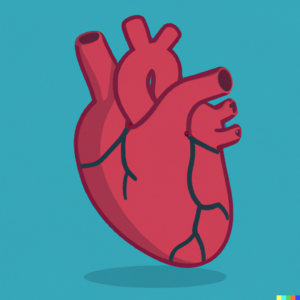⏰ Last Update: 14.08.2024
The heart is an essential organ in the human body, responsible for pumping blood throughout the body to supply oxygen and nutrients to every cell. It also removes waste products like carbon dioxide. Understanding the heart’s function and maintaining its health are crucial steps towards living a long and healthy life.
Anatomy of the Heart
Structure
The heart, an approximately fist-sized organ, is located centrally in the thorax within a space called the mediastinum, which is flanked by the lungs and protected by the sternum at the front and the spine at the back. Wrapped by a protective sac known as the pericardium, the heart is anchored in place by major blood vessels – the superior and inferior vena cava, the pulmonary arteries, and the aorta.
Anatomically, the heart is divided into four chambers, two atria (singular: atrium) and two ventricles, separated by a muscular wall known as the septum. The right and left atria are the upper chambers, which receive blood coming into the heart. Below them are the right and left ventricles, the pumping chambers that push blood out of it.
Function
Each heart chamber plays a role in blood circulation, guided by valves that ensure one-way blood flow. The right atrium receives deoxygenated blood from the body and passes it to the right ventricle. The ventricle sends it to the lungs, where carbon dioxide is replaced with oxygen. This oxygen-rich blood returns to the heart, entering the left atrium and moving into the left ventricle, which pumps it into the aorta and then to the body. The heart’s electrical system controls the heart rate and coordinates the contraction and relaxation of the chambers for efficient blood circulation.
Understanding the structure and function of this vital organ is essential, as it underpins the various processes that keep us alive, from the delivery of oxygen to cells for energy production to the removal of waste products from the body’s metabolic activities.
Common Heart Diseases
Coronary Artery Disease (CAD)
CAD, the most common heart disease, occurs when the coronary arteries, which supply the heart muscle with oxygen-rich blood, become hardened and narrowed due to a buildup of cholesterol and other materials, a condition known as atherosclerosis. This can lead to reduced blood flow to the vital organ, causing chest pain (angina), shortness of breath, and other symptoms. If a coronary artery becomes entirely blocked, it can result in a heart attack.
Heart Failure
Heart failure, often referred to as congestive heart failure, occurs when it can’t pump blood as efficiently as it should. This can result from conditions that overwork the vital muscle, such as high blood pressure and CAD. Symptoms may include shortness of breath, fatigue, and swelling in the legs, ankles, and feet.
Arrhythmias
Arrhythmias are abnormal rhythms. They occur when the electrical impulses that coordinate the heart’s beats are not working correctly, causing it to beat too fast, too slow, or irregularly. Arrhythmias can range from harmless to life-threatening.
Valvular Heart Diseases
Valvular heart diseases involve damage to or defects in one of the four valves: the mitral, aortic, tricuspid, or pulmonary valves. Issues may involve stenosis (narrowing of the valve), regurgitation (backward flow of blood due to a valve not closing properly), or atresia (a valve lacking an opening for blood to pass through).
Cardiomyopathy
Cardiomyopathy refers to diseases of the heart muscle. In cardiomyopathy, the muscle becomes enlarged, thick, or rigid, and in rare cases, the muscle tissue is replaced with scar tissue. As the condition worsens, the this vital organ becomes weaker and less able to pump blood through the body and maintain a normal electrical rhythm.
Congenital Heart Defects
These are abnormalities present at birth. They can often affect the formation of the muscle, chambers, or valves and disrupt normal blood flow. While some congenital defects are minor, others can cause serious complications.
Symptoms of Heart Diseases
While symptoms can vary depending on the specific type of disease, there are common signs that should not be overlooked. These include
Chest Pain or Discomfort (Angina)
This can feel like pressure, tightness, or aching in the chest. The feeling may either be constant or come and go, and it can sometimes spread to the arms, neck, jaw, back, or stomach.
Shortness of Breath
This symptom may occur when you’re exerting yourself or lying down. The vital organ can’t pump blood to the lungs and the rest of the body efficiently, leading to difficulty breathing.
Palpitations
Palpitations can feel like your heart is racing, pounding, fluttering, or has skipped beats. It’s a common symptom in many diseases, including arrhythmias and cardiomyopathy.
Fatigue
You might feel unusually tired or weak. This can be due to the heart’s inability to pump enough blood to meet the body’s needs.
Swelling in Legs, Ankles, and Feet
This is often a sign of heart failure, a condition in which the heart doesn’t pump blood effectively. As a result, fluid can build up in tissues, causing swelling.
Dizziness, Lightheadedness, and Fainting
These can be symptoms of many conditions, including arrhythmias, heart failure, and valvular heart diseases.
Blue or Pale Color to Skin, Lips, or Fingernails
This may be a sign of a congenital defect or heart failure, where it isn’t able to provide enough oxygen-rich blood to the body.
If you experience any of these symptoms, particularly if they are new, worsening, or associated with physical activity, seek medical attention promptly. Early detection and management of heart disease can prevent serious complications.
Risk Factors for Heart Disease
Several factors increase the likelihood of developing a disease. They can be divided into modifiable (those you can change) and non-modifiable risk factors (those you can’t change):
Modifiable Risk Factors
High Blood Pressure (Hypertension)
This condition forces the vital organ to work harder to pump blood, straining it and damaging the arteries over time, which can lead to various diseases.
High Cholesterol Levels
Excessive levels of low-density lipoprotein (LDL) or “bad” cholesterol can lead to the formation of plaques in the arteries (atherosclerosis), which increases the risk of coronary artery disease and other conditions.
Obesity
Carrying excess weight strains the vital organ and increases the risk of developing other risk factors such as high blood pressure, high cholesterol, and diabetes.
Diabetes
High blood sugar levels can damage blood vessels and nerves that control the heart and blood vessels, increasing the risk of disease.
Smoking
Nicotine in cigarettes constricts blood vessels, forcing the vital organ to work harder. Chemicals in cigarette smoke can also damage blood vessels.
Unhealthy Diet
Diets high in saturated fats, trans fats, salt, and cholesterol can contribute to the development of heart disease.
Physical Inactivity
Lack of exercise contributes to unhealthy body weight and can increase blood pressure and cholesterol levels.
Alcohol Use
Drinking alcohol in excessive amounts can raise blood pressure levels and the risk of disease.
Chronic Stress
Prolonged stress, if not managed effectively, can contribute to heart disease through its effects on other risk factors like blood pressure and cholesterol levels.
Non-Modifiable Risk Factors for Heart Disease
Age
The risk of disease increases with age, as the heart and blood vessels naturally undergo changes that can contribute to heart disease.
Family History
If a close family member had heart disease at an early age, your risk may be higher.
Gender
While heart disease affects both men and women, certain conditions affect one gender more than the other. For example, men are generally at a greater risk at a younger age, while women’s risk increases after menopause.
Race/Ethnicity
Certain ethnic groups, like African Americans, have a higher risk of heart disease, partially due to higher rates of hypertension and diabetes in these populations.
By understanding these risk factors, you can take proactive steps to manage those that are within your control. Additionally, incorporating a supplement like GinkgoVin, which supports circulatory health, can be a beneficial part of your heart health strategy. Always consult your healthcare provider for personalized advice.
Treatment and Management of Heart Disease
Managing heart disease typically involves a combination of lifestyle modifications, medications, and in some cases, surgical interventions. Here are the specifics:
Lifestyle Changes for a Healthy Heart
Healthy Eating
Adopting a diet rich in fruits, vegetables, lean proteins, and whole grains, while low in saturated fats, trans fats, sodium, and cholesterol, can help manage cardiovascular health.
Regular Exercise
Engaging in moderate-intensity exercise for at least 150 minutes a week, or vigorous intensity exercise for 75 minutes a week, can strengthen your heart and improve circulation.
Quitting Smoking
If you smoke, quit. Smoking is a major risk factor for heart disease. The moment you quit, your risk begins to decrease.
Limiting Alcohol
Excessive drinking can raise your blood pressure and increase your risk of heart disease. Limit intake to moderate levels, defined as up to one drink a day for women and two for men.
Managing Stress
Effective stress management, such as relaxation exercises, mindfulness, and adequate rest, can help reduce the strain on your heart.
Medications
Depending on the specific condition, various medications may be prescribed, including statins to lower cholesterol, beta-blockers to manage high blood pressure, antiplatelet or anticoagulant drugs to prevent blood clots, or ACE inhibitors to relax blood vessels and lower blood pressure.
Surgical Procedures
More severe disease cases may require interventions like angioplasty to open blocked arteries, bypass surgery to create a new route for blood flow, or in advanced cases, a transplant.
GinkgoVin
Alongside conventional treatments, natural supplements can provide additional support for heart health. One such supplement is GinkgoVin, which combines Ginkgo Biloba and Grape Seed extracts, both known for their beneficial effects on circulation and vascular health.
Ginkgo Biloba is known to enhance both cerebral and peripheral circulation, thus facilitating efficient delivery of oxygen and nutrients to vital organs. By supporting robust blood flow, Ginkgo Biloba can contribute to better heart health.
Grape Seed Extract is celebrated for its potent antioxidant properties and its ability to improve blood vessel elasticity and reduce inflammation. By fostering healthy blood vessels and maintaining optimal blood pressure levels, it can significantly contribute to overall cardiovascular health.
Thus, GinkgoVin serves as a natural support system for your heart, complementing traditional treatments and lifestyle modifications. However, as with any new supplement, always consult your healthcare provider before starting GinkgoVin, especially if you have existing health conditions or are taking other medications. Learn more at: https://botaniclife.ng/product/ginkovin/
Conclusion
Maintaining heart health is of paramount importance due to the critical role that it plays in our overall health. The heart, a tireless pump that circulates blood throughout the body, is central to the delivery of oxygen and nutrients to every cell. Due to its relentless work, the heart can be vulnerable to damage, and maintaining its health is vital.
Maintaining heart health requires a comprehensive approach, including a balanced diet, regular physical activity, stress management, and medical treatments when necessary. GinkgoVin can play a supportive role in this endeavor, promoting vascular health and efficient circulation. As with any supplement, it’s essential to consult your healthcare provider before starting a regimen with GinkgoVin: https://botaniclife.ng/product/ginkovin/




